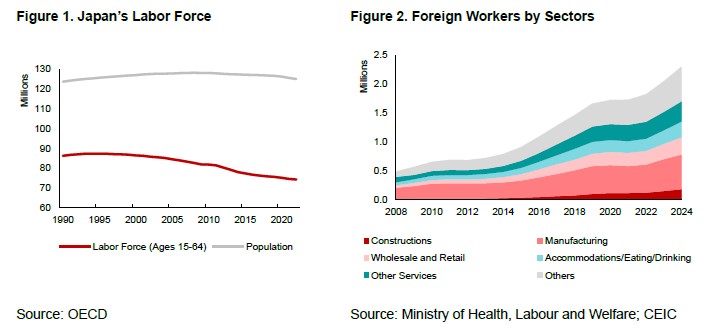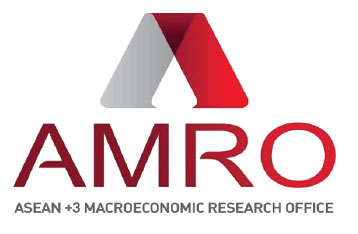Japan introduced an important reform to its foreign labor policy as part of its ongoing efforts to leverage foreign manpower to address the country’s chronic labor shortage. The revamp of the low- to mid-skilled immigration framework symbolizes a major shift in response to deepening demographic challenges.
This article traces the key policy developments leading up to the latest reform and explores what more can be done to attract and retain foreign talent in Japan.
Rising demand for foreign workers amid a shrinking workforce
Japan has long grappled with a shrinking working-age population (Figure 1). With labor force participation rates already high— at 76 percent for women and 25 percent for seniors, both above the OECD averages of 67 and 16 percent respectively—the country continues to face growing difficulties in meeting labor demand. While automation and labor-saving technologies offer partial relief, acute labor shortages persist in key industries, especially healthcare, construction, and manufacturing.
To address these gaps, Japan has been gradually opening its doors to more foreign workers. The number of foreign workers has quadrupled from just under half a million in 2008 to 2.3 million in 2024, with growth accelerating in the years following the pandemic (Figure 2). Most foreign workers are employed in manufacturing and services sectors, with the biggest shares coming from Vietnam (25 percent) and China (18 percent).
Despite the increasing numbers, foreign population still makes up only 2 percent of Japan’s total population—well below the OECD average of 10 percent. Similarly, foreign workers constitute around 2 percent of the country’s labor force. This indicates both a cautious and targeted approach to immigration policy and an untapped potential for expanding the foreign workforce.

A skill-based approach
Japan’s immigration framework includes different pathways for foreign workers based on skill level.
For highly skilled professionals, Japan offers work visas in fields such as science, engineering, business, and healthcare. This demand-driven system, free of industry-specific quotas, gives businesses the flexibility to recruit talent as needed. A point-based system further supports the attraction of qualified individuals with relevant educational background or professional experience by offering incentives such as fast-track permanent residency and family visas for high-scoring candidates.
For low- to mid-skilled workers, Japan has traditionally relied on the Technical Intern Training Program (TITP), which was initially designed as a skills-transfer initiative under international cooperation. However, since the program requires participants to return to their home countries after a few years, it has proven inadequate for meeting Japan’s long-term labor needs.
A major shift to this occurred in 2019 with the introduction of the Specified Skilled Worker System (SSWS). This framework enables Japan to admit work-ready mid-skilled foreign nationals into industries facing severe labor shortages, such as nursing, food services, food and beverage, manufacturing, and construction. Unlike the TITP, the SSWS provides a pathway to long-term employment and residency for workers who pass the required skills and language tests.
Toward a sustainable workforce
More recently in 2024, Japan announced additional major enhancements to its immigration framework for low- to mid-skilled workers. Recognizing the need for a more streamlined and sustainable approach in this segment, the government plans to replace TITP with the new Employment for Skill Development (ESD) Program starting in 2027.
Designed to develop and retain essential human resources, the ESD will serve as an entry point for the SSWS. Low-skilled foreign workers will be admitted into the ESD program to undergo three years of skills development. Upon completion, they will be eligible to transition into long-term employment under the SSWS. Importantly, ESD offers improved employment conditions compared to TITP, including greater job mobility and stronger labor protections.
Japan has made commendable progress in adapting its immigration policy to address the challenge of shrinking labor force from the rapidly aging population. Still, more can be done to attract and retain foreign talents. Key areas for improvement include enhancing work conditions, offering competitive wages, and fostering social integration. With the right policies in place, foreign workers can play an important role in revitalizing Japan’s economy and supporting the advancement of strategic industrial clusters. Japan’s evolving experience also offers valuable insights for other ASEAN+3 economies facing similar demographic shifts.
